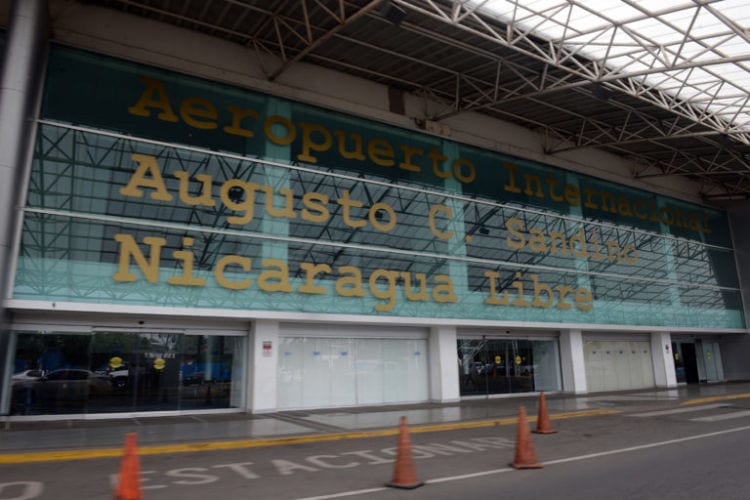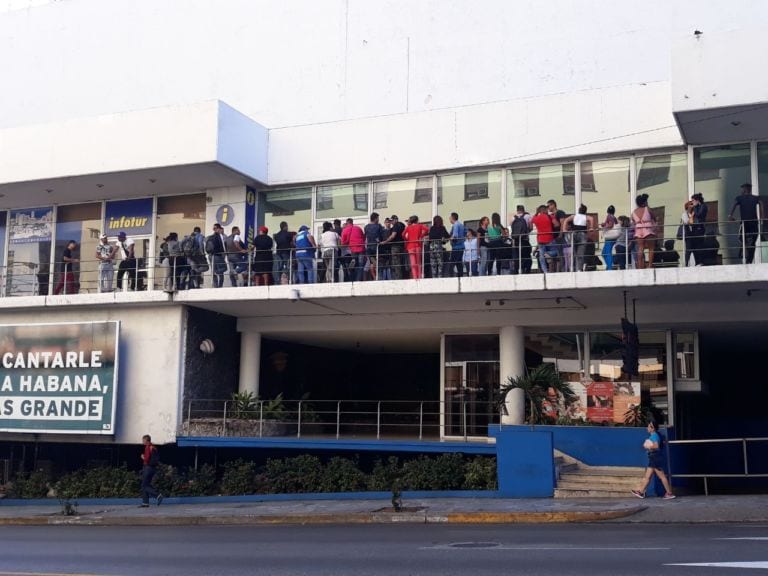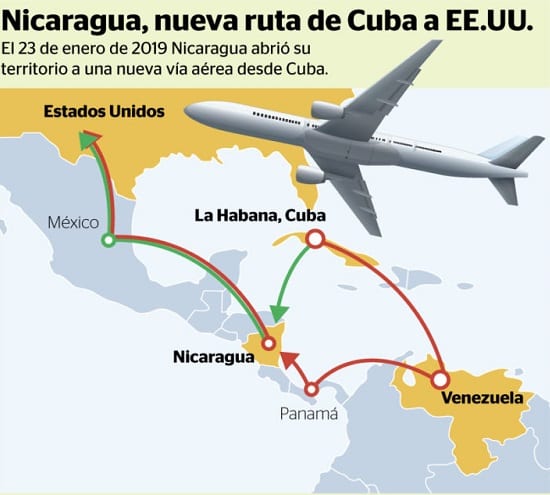Nicaragua, Cubans New Springboard to Reach the USA

Since January, Cuba now features on Nicaragua’s immigration category B list, which allows Cubans to receive a tourist visa from the consulate directly without having to wait for Immigration in Managua to approve the application, this institution confirmed to this newspaper.
By Luz Escobar, Jose Silva, Mario J. Penton (La Prensa)
HAVANA TIMES – “There aren’t any flights until May,” an employee at Avianca airlines tells the crowd of people who line up. They sell plane tickets to Nicaragua at their office, located on the ground floor of the Habana Libre hotel in Vedado, and ever since late January, there has been a long line out the door.
When Cubans discovered that visa conditions had been made more flexible for this Central American country, dozens began to crowd in this centric Havana building’s corridors, waiting their turn. Others didn’t squander the new business opportunity. “If you want to go in, you have to pay between 20-50 CUC,” a man tells a young lady who has turned up without knowing that it’s better to go the night before and put your name down on a list.
Since January, Cuba now features on Nicaragua’s immigration category B list, which allows Cubans to receive a tourist visa from the consulate directly without having to wait for Immigration in Managua to approve the application, this institution has confirmed to this newspaper.
“This change means that visas that had to previously be approved in Managua (because Cuba was previously classed in the C category), can now be approved by a consul in Havana. It’s a much more simple and faster process,” an official at Nicaragua’s Immigration offices said, asking to remain anonymous. Cubans only need a valid passport, to fill out the forms, declare their interest in going to shop and pay for the consular service.
Other countries within the region have other requirements such as showing a clean criminal background check or proving that they have over 500 USD in their bank account, but this isn’t the case for Nicaragua.
“The Ortega government is desperate to inject hard currency into the economy after tourism has dwindled. Plus, other countries within the region have relaxed their visa requirements for Cuban citizens, and a large number of tourists will help the national economy,” the same source explained.
Cubans are compulsive buyers, buying everything they need back on the island. The so-called “mules” go to other countries in the region and buy clothes, shoes, electrical appliances or spare car parts to then resell them on the black market. When state stores have great shortages, this influx of goods becomes essential.
It’s still too early to have exact figures about how many Cubans will travel to Nicaragua for this end, which is what Daniel Ortega’s government hopes for, but there are already Cubans using the country as a springboard to reach the United States’ southern border, where they then request political asylum claiming that they are being persecuted by the government on the island.

Official statistics reveal a drop in the number of Cubans who have visited this Central American country since 2016. In 2015, during the immigration crisis, the Nicaraguan government stopped Cubans from heading to the US by shutting down its border with Costa Rica. That year, 3921 Cubans traveled to Managua on a direct flight, which has since fallen to 1528 after the US revoked its wet-foot/dry-foot policy in 2017.
From Havana to Managua
El Chino (as he is known by his friends and neighbors) is 28 years old and has received a visa to travel to Nicaragua. “I was one of the first ones to get an appointment after visa requirements were made more flexible,” he explains.
The visa application process wasn’t very hard for him, he admits “A friend gave me the Nicaraguan consulate’s email address. I wrote to them saying that I wanted to go there and shop, and they responded and sent me some forms,” El Chino says. Soon after, they scheduled an appointment at the consulate for him, he turned up with his passport and paid 30 CUC for the visa application at the International Finance Bank. “There was a queue because there were many people wanting to do the same thing, but when I went to get my visa in early February it wasn’t as crazy as it is now,” he adds.
His relatives in the US helped make some of the process easier for him. In Miami, his brother brought him the plane ticket at Avianca’s offices after managing to get a transit permit in Colombia, and his cousin booked him a place to stay while in Managua. “It’s a small place, for two nights, but when I get there I can find my bearings and make the contacts I need to head north.” This is the first time he is leaving Cuba and the only thing he knows about Nicaragua is that “there are lots of volcanoes.”
As soon as he lands, he’ll start calling some contacts that various Cuban friends have given him, who have made the same trip before him. He’ll close a deal, pay some of the money upfront and another part when he reaches the US border. And, he will remain at the mercy of human traffickers and human trafficking networks, who make a living off immigration through Central America.

El Chino’s father has given him some advice because in the ‘80s, he was in the Central American country as a military collaborator. “People won’t know you’re not from there until you open your mouth, because you look like the Nicaraguans,” the father says. “Stay clear of any place where you see them protesting against Ortega, because then you will find yourself in a tricky spot.” A backpack, some hiking boots and a cellphone with a SIM card that works in Central America are the migrant’s main pieces of baggage.
In spite of warnings and stories about robberies, rape and murders en route to the US, El Chino seems determined to make the trip.
But, Nicaragua’s coffers won’t get very much from him. “I’m not even going to buy a piece of gum because I want to save all the money I have for any unforeseeable thing on my way north,” he says definitely.
In Sandino’s Homeland
Jorge and Moraima are at a gas station near Managua’s International Airport, on the North Highway. They say that they are a couple from Matanzas and they are between 30-40 years old, but they don’t want to disclose their real names or their final destination.
They left Havana for Managua on a Conviasa flight in mid-March and explain that they are happy to have made the leap, although their faces reflect distrust more than anything else.
“We are here getting to see Nicaragua. I always wanted to come and now that we are here, we are happy to finally get to know the home of Sandino, the birthplace of Ruben Dario and Carlos Fonseca’s mountains,” he says in a bothered tone.
Both of them are university-educated professionals. She is a biologist and he is a physical education teacher and professor of math, physics and logic. They aren’t heading for the Empire, of course. They have come on holiday and are returning to Cuba with some books, clothes and other things they have bought. “It isn’t a lot, but the idea to enjoy this beautiful country,” Jorge says. And Moraima looks this way and that, hiding her hands, after having refused to be photographed and wear a microphone.
Marcos and Carlos have also adopted fictitious names. They are both 40-something years old, and have come from Havana too. They arrived last week, their hearts set on reaching the US. “We have invested a lot of money in this trip, but we are going to try and do things the right way. If we have to ask for a visa to get to Honduras, Guatemala and Mexico, we will. We don’t want to travel as part of any caravan or go anywhere we aren’t supposed to. If we get there, we would have done it the right way,” Carlos says, convinced.
Even though the US, working hard and sending back money to their families is the objective, they haven’t ruled out settling down in Panama or Costa Rica to make a living if they don’t make it. But, they aren’t thinking about settling down in Nicaragua. “Returning here with Daniel [Ortega] would be like going back to Cuba with Fidel…,” he says.
Even though they know very little about the country they’ve just traveled to, they do know one thing: “We aren’t traveling alone. State Security come on these flights too and you never know who is sitting next to you,” Marcos says. Carlos backs this up: “One thing people told us was to keep quiet on the plane, not to criticize, and don’t say where you’re going. And that if a journalist asks you anything, you just say that everything is great here and there,” he says laughing.
When they landed, they were asked for their stamped visa in their passports and 10 USD to enter. You’re all set, welcome to Nicaragua, they were told.
Now, they are staying in Managua, in a hostel that costs 12 USD per night, where they will make the arrangements for their trip by land to Mexico.
There are 80-90 passengers on each 7701 Conviasa flight, direct from Havana three times a week: Monday, Wednesday and Friday between 6:50 and 7:15 PM. While an average of 30-40 Cuban passengers make it to Nicaragua on other flights, such as Copa and Avianca, per day. There are between 450-520 Cuban migrants per week. Return flights are emptier. Thirty being the maximum, sometimes 20 and only 10 once, according to a source at Immigration and Foreign Affairs Ministry said, who also preferred to remain anonymous.
Knocking at the US’ door
Reinier and his girlfriend, Yedsika, have been staying at a government-run shelter in the city of Acuna, in Coahuila State in north Mexico, for two weeks now. He is 34 years old and she is 29. Like all migrants who have made their way through Central America, they say that they could write a “book” about all the things they’ve gone through. They are waiting in a line that seems to be never-ending, organized by Mexican officials, the application line to ask for political asylum from US authorities.
“The first week, we ate with the money that my cousin sent us, who lives in Houston, but we have had to go out and look for work because it wasn’t enough,” Reinier laments, who arrived in Nicaragua from Havana over a month ago.
“My cousin managed to get in touch with a coyote (human trafficker), who wrote to us on Messenger when we were still in Cuba. He took us all the way until he left us in Tapachula,” he says. The trip costs 1500 USD each.
After crossing the Nicaragua-Honduras border, they had to wait for a week almost for the letter of safe passage this country gives you. Between January and February this year, Honduras’ Immigration Authorities have arrested 1372 Cuban migrants who were trying to travel through the country illegally, without this document. In Tapachula, it took them another week to get similar authorization from Mexico that allows them to stay legally.
“Here, there are people who have been waiting two months for their turn to request political asylum. The US are only calling one case in a day. It’s a very slow process and there are hundreds of Cubans waiting,” the migrant complains. Reinier and his girlfriend weren’t mixed up in politics, they didn’t even read independent media, but they say that they deserve asylum because they are fleeing the “tyranny of Castrismo”.
“Nobody can live in Cuba. It’s getting worse and worse every day. The only thing you can do is go to the jungle and try to live freely,” he says on the phone from Acuna. Their appointment to request asylum has been set for next month. Meanwhile, they live with the hope of not being repatriated back to the country that has cost them so much to leave.
This article was written with the contributions of Luz Escobar, Jose Silva, Mario J. Penton, from Havana, Managua and Miami.






Comments are closed.